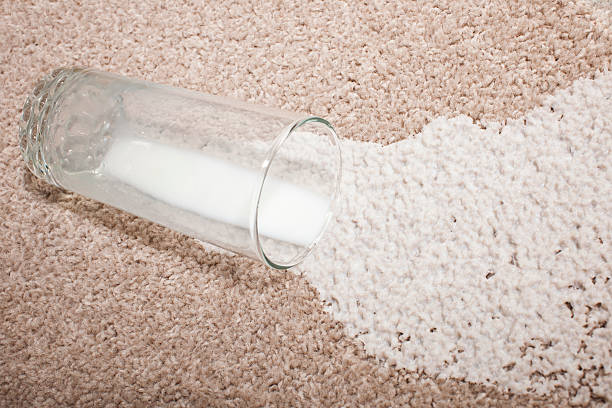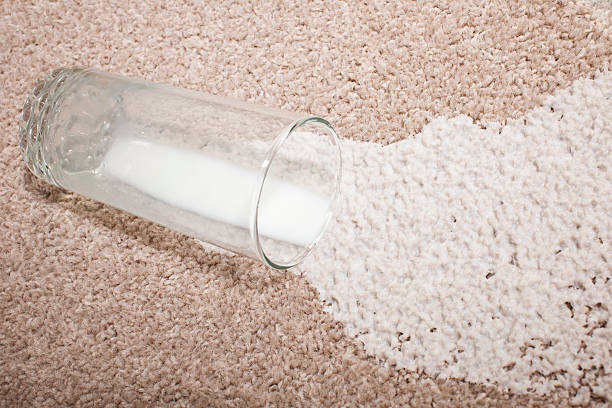
A little spilled milk on the carpet may appear easy to handle at first glance, but this could be further from the truth. Milk leaves stubborn stains and a unpleasant smell you’ll want to avoid at any cost. Still, with the right approach, you can rescue your carpet. Our carpet cleaning experts are sharing a few tried-and-tested cleaning methods to know how to remove milk stains from carpets using products and ingredients you might already have at home.
A wet/dry vacuum is a great tool to remove the excess milk from your carpet.
Get Rid of the Excess Milk From Carpet
Proteins and lipids present in milk are excellent sources of energy for the body but harmful for your carpet. When Proteins and fats dry they form a strong connection with fabrics , making stain removal challenging. Moreover, over time, the natural sugars in milk are converted by bacteria into acetic and lactic acid. If you don’t clean up the spill right away, it will become yellow and release unpleasant smell. Therefore, the first step is to get rid of as much milk from the carpet as you can, regardless of the cleaning technique you decide on.
Removing Freshly Spilled Milk From Carpet
Take a bundle of paper towels or a clean, absorbent towel and gently put on the affected area. Depending on the volume of the spill, the thickness of your carpet’s pile, and the duration of time that has passed, the milk may have penetrated deeply into the fibers. If this is the case, then apply pressure to the area to absorb the liquid from the padding underneath. Continue blotting until the cloth is dry, ensuring maximum absorption of the milk.
Dealing with Dried Milk Stain From Carpet
If dried milk spill is visible on carpet then, use a spoon to carefully scrape away the dried milk and then use vacuum to any remaining residue. Lightly spray the spot with clean, lukewarm water. Rinse the area by blotting it with a clean, damp cloth, then pat it with another clean, dry cloth to completely remove any remaining residue.
Once you’ve dealt with the excess milk, you can remove the stain from your carpet using one of the methods outlined below. Whatever product you choose, always start cleaning the outside of a spill and work toward the center to prevent the stain from spreading.
Also, remember that some carpets might require a visit from your local cleaner. We highly recommend professional stain removal and carpet cleaning for all oriental rugs, carpets made entirely of natural fibres like cotton or wool, as well as carpets made from viscose (bamboo silk).
A few drops of powerful dishwashing liquid can do wonders in removing fresh milk stains.
Cleaning Method 1: Dish Soap and Water
Pour one cup of cold water into a bowl and add a few drops of gentle dishwashing liquid. Stir well to combine the ingredients. Dip a clean sponge or cloth into the bowl, wringing out most of the liquid so the sponge is slightly damp but not saturated. Begin by lightly blotting the milk stain, working from the outer edge towards the center of the affected area. Rinse the sponge or cloth frequently, dipping it back into the solution and continuing to blot. You’ll know you’re ready to move on when the rinsing water runs clear. Finish by giving the area one final rinse and then dry it using a clean cloth.
You can use a brush to distribute your solution more easily onto shaggy carpets.
Cleaning Method 2: Ammonia Solution
If the milk stain remains visible after using the previous method, dilute a tablespoon of ammonia in two cups of lukewarm water and work on the area again. Apply the solution onto the carpet using a sponge and continue to blot until the stain is no longer visible. Rinse the area with a clean sponge and cold water. Finally, blot the carpet dry with a clean cloth to complete the milk stain removal process.
Enzyme cleaners are your best friend if your toddler is still learning how to use a spoon.
Cleaning Method 3: Using Enzyme Cleaner
If you have small children, you’ve already realized you’ll have to deal with stains quite often in the foreseeable future. That is why we recommend arming yourself with a good enzyme cleaner and having it at hand when (the inevitable) milk spill occurs. Here’s how to proceed.
- Remove the excess milk.
- Spray your carpet with some water and apply the enzyme cleaner according to the instructions on the product label.
- After you are done, extract the product by blotting it with a dampened white cloth.
- Lift the cleaner completely, rinsing the towel with clean water until it stops releasing soapy residues.
- Blot the carpet with a clean towel to dry it.
Note! This method is not suitable for cleaning wool carpets as enzyme cleaners can damage them.
Leave the baking soda for at least 4 hours before vacuuming it from your carpet so it has enough time to absorb the smell.
Eliminate the Lingering Milk Odour from Your Carpet
Spoiled milk has an unpleasant smell that can persist even after the visible stain has been removed. If you still detect the odour, baking soda is a handy tool for absorbing unwanted odours, and it’s something most of us typically have at home. Sprinkle a generous amount of baking soda over the affected area, whether wet or dry, and leave it overnight. The following day, thoroughly vacuum the area to remove the baking soda, and voilà! The odor will be gone.
The Hire Carpet Cleaner provides a wide range of professional cleaning services in Australia. If you need help removing stains from your carpet, then don’t hesitate to contact us and request a free quote.


No comments yet